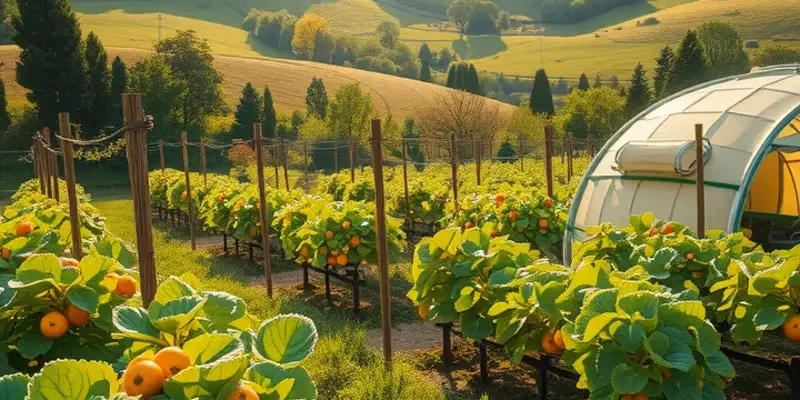Effective food storage is essential for reducing waste and enjoying fresher produce. By implementing eco-friendly practices, you can prolong the life of your fruits and vegetables while minimizing spoilage. This guide offers actionable tips for sustainably storing produce, allowing you to make the most of your grocery purchases and contribute to a healthier planet.
Maximizing Freshness: The Art of Storing Fruits and Vegetables

Effectively storing fruits and vegetables requires more than simply placing them in the refrigerator. Each type of produce has unique characteristics that influence how and where they should be stored. With thoughtful preparation and a bit of knowledge, you can ensure your fruits and veggies remain fresh and nutritious for as long as possible, greatly reducing waste and saving money.
Understanding the Basics
First, consider that moisture, temperature, and ethylene gas play crucial roles in how long produce remains fresh. Most fruits release ethylene, a natural gas that hastens the ripening process, while many vegetables are sensitive to it. Separating ethylene-producing fruits from ethylene-sensitive vegetables is a simple yet effective strategy in extending shelf life.
Cold Storage: Ideal for Many but Not All
Refrigerators work well for many types of produce. Leafy greens like lettuce, spinach, and kale benefit from being stored in their original bags or wrapped in a damp cloth and placed in the crisper drawer. This maintains moisture while keeping temperature fluctuations at bay. Vegetables like carrots, celery, and broccoli should also be stored in the crisper, wrapped in damp paper towels to maintain freshness.
Fruits like apples and berries last longer when refrigerated, but make sure berries are not washed until you’re ready to eat them. Washing in advance introduces moisture that can cause quicker spoilage.
Cool and Dark Places: A Must for Some
Potatoes, onions, and garlic prefer cool ventilated spaces, away from direct sunlight. Exposure to light can cause potatoes to sprout and spoil sooner. Similarly, onions and garlic should be kept in a well-ventilated container to avoid moisture build-up, which can lead to rot.
Winter squashes can last weeks or even months at room temperature when stored in a cool, dry area. This makes them a stellar choice for those aiming to stock up on long-lasting produce.
Counter-Friendly Produce
Not everything belongs in the fridge. Bananas, tomatoes, and stone fruits such as peaches and plums do best on the counter until fully ripe. Once ripened, moving them to the refrigerator can help extend their freshness by several days.
Citrus fruits are another counter-friendly option, although they can also be stored in the fridge to prolong shelf life if necessary. This flexibility makes them versatile in managing kitchen space as needed.
Harnessing Technology
Sometimes simple tech can make a significant difference. Invest in breathable produce bags to reduce moisture and prevent spoilage, or use ethylene absorbers to decrease ripening speed in your fruit drawer.
For further guidance on eco-smart storage solutions, consider exploring eco-smart kitchen storage where innovative ways to preserve food quality while minimizing waste are discussed.
By implementing these strategies, you’ll not only keep your fruits and vegetables fresh for longer but also contribute to a sustainable, waste-conscious kitchen practice. This forms a cornerstone of eco-friendly living by maintaining the quality and nutritional value of your produce while reducing waste and enhancing your meals.
Sustainable Methods and Tools for Home Food Storage

Storing food sustainably begins with understanding the advantages of natural materials. Glass, stainless steel, and aluminum offer durable, recyclable alternatives to plastic. Glass jars, for example, are ideal for preserving the freshness of sliced fruits and vegetables. Their non-porous nature ensures an airtight seal, maintaining the flavors and nutrients of your food.
Using fabric-based storage solutions like beeswax wraps can also preserve perishables effectively. Beeswax wraps are made by infusing cotton fabric with beeswax, tree resin, and jojoba oil. This combination creates a flexible and reusable wrap that clings to bowls or food items. Unlike plastic wrap, beeswax covers are biodegradable, offering a compostable alternative for preserving cuts of cheese or half-used produce.
Additionally, the minimalist’s favorite—mason jars—can be repurposed effortlessly. They store everything from leftovers to bulk pantry items. Their transparency allows for easy visibility, helping to prevent food waste by reminding you what you have before expiration. Pairing these jars with chalkboard labels or erasable markers enables effective tracking of contents and their use-by dates.
Embrace the practice of utilizing root cellars. A root cellar employs natural underground temperature regulations to store root vegetables, apples, and cabbages. These can be crafted at home using simple materials and are an outstanding way of minimizing energy use while keeping food fresh longer.
For a compact solution, the traditional clay pot or “Zeer” pot is ingenious for regions without access to modern refrigeration. This dual-pot system combines one small pot within a larger one, separated by moist sand. As the moisture evaporates, it cools the inner pot, creating natural refrigeration. Ideal for storing tomatoes, leafy greens, or dairy, this method is time-tested in maintaining produce freshness.
Managing food waste doesn’t only involve material choices but also adopting strategic approaches. Begin by rotating groceries, a simple method of first-in, first-out. This technique ensures older products get consumed before fresher ones. Additionally, batch cooking and meal prepping can significantly reduce waste. Preparing meals for the week prevents food from languishing in the refrigerator unused and provides quick access to nutritious dishes.
For those interested in further insights into low-waste cooking practices, exploring low waste cooking prep methods can provide effective strategies. Education on how to maximize and reuse ingredients reduces dependency on frequent grocery visits and inspires creativity.
Incorporating these sustainable storage methods and tools can make a noticeable difference. Not only do these efforts contribute to a reduction in plastic use, but they foster a conscientious approach to home food management. By committing to these practices, one supports both environmental and household sustainability.
Final words
Proper food storage not only ensures that your produce remains fresh but also plays a crucial role in minimizing waste. By adopting the eco-safe storage techniques outlined in this guide, you can enjoy your fruits and vegetables for longer while contributing to a healthier environment. Remember to assess your food regularly and adjust your storage methods to suit seasonal produce. With commitment and awareness, you can transform your kitchen into a sustainable haven that respects both resources and your health.







